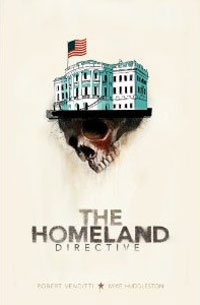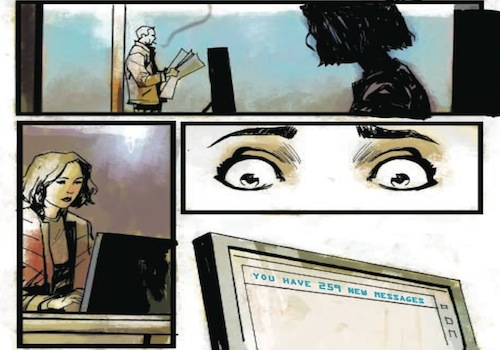 Robert Venditti: The Homeland Directive (Top Shelf, 6/7/11, $14.95)
Robert Venditti: The Homeland Directive (Top Shelf, 6/7/11, $14.95)
The Homeland Directive, the new graphic novel by The Surrogates author Robert Venditti, addresses some of the difficulties of the modern war on terror in the guise of a suspenseful and artistic graphic novel. Beautiful, innovative art, some brilliant moments, and trenchant comments by the main characters elevate the story above the average artistic-political commentary, like that of a decent episode of 24. However, Venditti’s ideas are occasionally confused and problematic. Overall, he succeeds wonderfully in creating a splashy and surprising conspiracy thriller, but he loses some points in the presentation of a muddled political message in its final act.
Dr. Laura Regan works as a microbiologist for the CDC and believes that she, along with the US government, is making the world safer for everyone. Soon, she is framed for the murder of her colleague, Ari, nearly assassinated by a man posing as a FBI official, and finds herself in the middle of a vast conspiracy that includes high-ranking members of various government agencies. Her band of rescuers (Pollack from the FBI, Gene from the Secret Service, and Wychek from the Bureau of Consumer Advocacy), who have discovered the truth about the conspiracy, provide some humor and variety in what otherwise would be a classic chase story adapted for the age of terrorism.

One of the highlights of the comic is its characterization of the supposedly benign Bureau of Consumer Advocacy. Handling complaints from disgruntled customers accounts for “about 7%” of its total operations, as Wychek explains. The rest involves compiling an Orwellian amount of personal data on anyone who has ever bought anything, used a credit card, or started a checking account. By tracking everyone’s transactions and movements, the bureaucrats are able to build a highly detailed profile of anyone — including Laura Regan. The inclusion of the BoCA adds a dose of paranoia and reinforces Venditti’s impression of the government as a shadowy network of spies, intent on controlling every aspect of our lives.
Without giving too much away, the story hinges on a point that Albert, the Secretary of Homeland Security, makes near the end of the novel. He asserts that the government cannot protect the people adequately when they still have personal freedom, and because people will never stand for having their freedom taken from them, they must be convinced to give up those freedoms of their own accord. In the case of the comic, he means homegrown terrorist attacks meant to scare people into allowing the government a wider jurisdiction over their lives. This debate should resonate with anyone who experienced the alarmism and terror of the past decade, in which newscasters and politicians have tried to convince the public that its freedoms were only standing in the way of its protection from shadowy terrorist organizations.
Venditti’s problem comes in when he shows the government, operating under Bush-era “by any means necessary” tactics, as wrongheaded, but also characterizes President Obama as a naïve and essentially weak individual. After being kept in the dark about Homeland Security’s plans for most of the comic, Obama can’t even properly punish Albert without damaging his own image. Venditti doesn’t offer any options for governance; only Laura and her protectors are capable of doing the right thing, and they survive by fighting against a ruthless and secretive network of government agents. Venditti’s message verges on “any government is bad government,” and yet he doesn’t quite promote anarchy. Instead, he seems to remind his audience not to place too much trust in the institutions that govern our lives.

Despite being a fairly by-the-numbers political thriller, The Homeland Directive boasts some beautifully experimental art. Working with a muted palette, illustrator Mike Huddleston grounds Venditti’s story in realistic yet art-deco surroundings, then adds judicious splashes of color to pick out certain objects or people. The effect is appropriately surreal, placing the story in a world that both resembles ours and works as an exaggerated hypothetical scenario. He works with a variety of mediums, from watercolor washes and colored pencils to color-fields and photographs. Each new setting has its own characteristic color palette and art style, immediately locating the reader in the changed scene, from the graphic-paper background of the BoCA to the monochromatic fuzzy interior of the Oval Office.
Though not exactly groundbreaking, The Homeland Directive is an intriguing look at the fears of Americans today, and a critical examination of the measures that a government will take to maintain control.
[Have you pre-ordered yet? Don’t miss our limited-time offer, saving up to 38%, for Chromatic: The Crossroads of Color and Music, our next book that profiles independent musicians and artists who explore color in unorthodox ways.]

